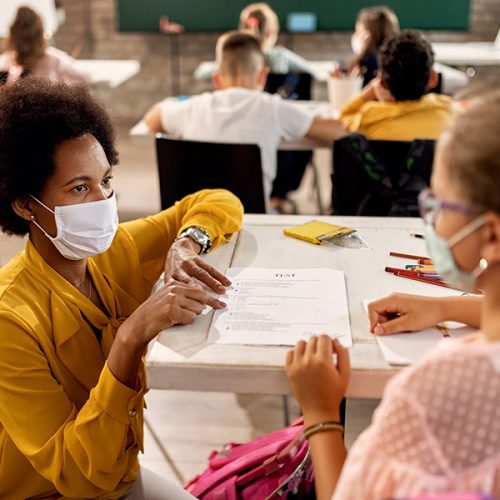Both students and teachers alike are working to adapt to what will be a very different look and feel to the academic year due to the ongoing presence of the COVID-19 virus. With distance learning being the new normal for many, the pandemic has presented a new set of challenges for children with vision and hearing loss. Mass Eye and Ear experts offer a few ways to best set your student up for success.
Hearing loss can impact a child’s learning in a classroom environment in a variety of ways, but amidst a pandemic where social distancing in person and remote teaching become the norm, these challenges can be exacerbated.
Dr. Michael S. Cohen, Director of the Multidisciplinary Pediatric Hearing Loss Clinic, broke down a list of ways to help your hearing impaired students make the best of distanced and remote learning.
Considerations for children with hearing loss for in-person classes
 When students with hearing loss are attending in-person classes with social distancing and mask policies, educators can help by doing these three things:
When students with hearing loss are attending in-person classes with social distancing and mask policies, educators can help by doing these three things:
Minimize background noise – To aid students with hearing loss, limit all competing noise. This could mean closing windows and doors and refraining from playing soft music during class. This advice also applies for at-home learning. Parents can help by removing pets and siblings from the room and trying to minimize the noise around the house.
Wear a see through mask if possible – Many students with hearing loss rely on visual cues such as the position of the lips and facial expressions to better understand their teachers. Wearing a mask hinders a student’s ability to do so. If possible, teachers should wear a face mask with a clear panel or a clear face shield to allow students to utilize these cues to better recognize what is being said. “We all rely on facial movements and expressions to help understand what people are saying. Clear face coverings can help students with and without hearing loss better understand their teachers.” said Dr. Cohen.
Clear communication – Although this might sound straight forward, it is critical to ensure there are clear lines of communication so that the students with hearing impairment are actually getting the information being taught. It is best to supplement spoken language with writing. You can do this by putting assignments, directions, and homework in written form. “Even when all other accommodations are in place, students with hearing loss will still miss or mishear parts of instruction and conversations,” Dr. Cohen explained ”Therefore, it is important to frequently repeat, rephrase, and clarify information.”
Tips for remote learning for children with hearing loss
Since students will be expected to use an electronic medium for class as well — some in hybrid models and other students who are at home for all schooling, here are three tips to improve the experience with e-learning for a child with hearing loss.
Have a good Wi-Fi connection – When connection to Wi-Fi is poor it can create spotty audio and visuals. Try sitting you child close to the router for better connection. Establish a good connection to Wi-Fi before the start of class so as not to fall behind.
Closed Captioning and assisted listening devices – Closed Captioning can be an extremely helpful tool for students with hearing challenges. It allows them to follow along with what is being said, but make sure that the virtual platform used by your school has the ability to use closed captioning. Many assistive listening devices and remote microphone systems are often capable of connecting directly to a media source such as a computer to give students better auditory access to videos, computer-based lessons, educational games, etc.
Give guidelines – To help maintain order and to limit extra noise and confusion for a student with hearing loss, educators can establish clear expectations for all students participating in your online class, such as:
- Mute yourself when entering the virtual classroom
- Unmute only when called on so that just one person speaks at a time
- To limit noise, raise your hand to be called on or type your questions in the chat box
- Video must be turned on (this allows students with hearing loss to also get visual cues from peers)
Navigating vision challenges and remote learning
Remote learning can be an advantageous setting for some children with low vision, Dr. Amy Watts, director of the Vision Rehabilitation Service at Mass Eye and Ear, explained to Focus. Students with visual impairment may be able to view documents and presentations more easily at home on a computer screen compared to in person learning environments which often utilize poor contrast white boards and degraded quality photocopies for near work.
“With curriculum posted on the computer and so many younger, low-vision children already being so adept at changing font size and other settings, remote learning on a computer might offer some benefits,” she said.
There are several tips to keep in mind to optimize the remote learning experience for children with low vision, according to Dr. Watts. Make sure the brightness and contrast levels on the screen are set adequately to help. Typically, children with low vision see better with increased brightness. Keeping a computer plugged into a power source will keep the battery level necessary to maintain brightness, and prevent it from going into a dimmer mode. For contrast levels, children with low vision are encouraged to increase the contrast levels which make the darker backgrounds darker and the whiter backgrounds lighter. A child may have difficulty reading photocopies or a newspaper in a classroom setting due to this lack of contrast, she said.
There are also numerous settings and apps a child can use to help the remote learning experience and prevent eye strain and fatigue, including those for magnification and speech-to-text. To get started, look under “Settings,” and then the “Access” or “Accessibility” tab which allows the user to customize the screen.
Low vision considerations for learning that takes place in person
If learning takes place in person, there are several common adaptions for children with low vision that teachers should look to implement. A few suggestions include seating low vision children in the front of the classroom to view the board, providing electronic versions of work sheets and reading materials, offering low-vision textbooks with larger fonts, and making sure overhead lights are bright for reading and navigating the classroom.
“Don’t forget, public and school libraries offer many books and newspapers in large print,” said Dr. Watts. “If a student is assigned a book that doesn’t have an electronic version, ask a librarian if they have a large print for low vision—they should carry many classic books.”
For more resources on how to better assist a child with hearing or vision loss during remote learning check out our website: https://masseyeandear.org/covid-19/hearing-loss-resources-students-teachers
About our Experts

Dr. Michael S. Cohen is a pediatric otolaryngologist who is Director of the Multidisciplinary Pediatric Hearing Loss Clinic at Mass Eye and Ear. He specializes in caring for children with hearing loss and other ear conditions. Dr. Cohen also cares for children with a wide range of ear, nose, and throat problems such as recurrent ear infections, obstructive sleep apnea, recurrent tonsillitis, neck masses, and sinus disease. He sees patients at the Mass Eye and Ear, Main Campus in Boston.
Amy C. Watts, OD, is an optometrist and director of both the Optometry and Contact Lens, and Vision Rehabilitation Services at Mass. Eye and Ear. She provides routine and specialized contact lens fittings.
is an optometrist and director of both the Optometry and Contact Lens, and Vision Rehabilitation Services at Mass. Eye and Ear. She provides routine and specialized contact lens fittings.
This was a wonderful article for both hearing and seeing. The hearing article was especially encouraging for future issues. I definitely have a severe hearing loss and the COVID Virus has added to my difficulty to understand what people are saying with mask on. I visited a physician today, could not understand what she was saying until she changed to a plastic face mask. The result was incredible. I feel this article will help many people, both old and young to understand what is being said. Thank you so very much for all the help and studies that are ongoing. I will definitely be happy to send a donation to Mass Eye and Ear. They have been tremendous help to me.
Sincerely, Jacquelyn Kudzma
Thank you so much for reading and your kind comment, Jacquelyn! We’re glad to see you say that our medical staff has been a help to you.